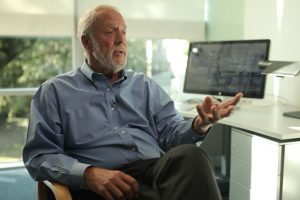Evolution of Humans
Biologist Steve Jones on natural selection, chimpanzees, and Queen Victoria
It calls quite a bit of excitement, it’s the notion that to fully understand how the brain works, how cognitive processes operate, you have to acknowledge – the brain is embodied, it lives in a body, it uses a body, it gets all its sensations through a body that carries sensory sheets, sensory organs – not only that, but the way that we acquire that information, whether we sample our world, whether we are coupled to the world depends upon it movement.
If you think about it, there’s very little that you can do apart from secretion without movement, without your body: speaking, looking at different parts of the world, perambulating, moving around, redeployment – nearly everything depends simply upon moving your body. So, the only way that the brain can talk to the environment is through its body. If you deny that and just look at the brain and some passive sensory filter that’s in a privileged position of receiving all this rich interesting sensory information, which you have to make sense of, you’re going to get a very false perspective on the game, which the brain is actually playing, which is not just about filtering and making sense of sensory input, it’s actually actively going out there and sampling that input, and using its body to do that under all the imperatives that having a body implies.
A practical problem that if you were devising robots that have to scan for dangerous operants at an airport, for example, you need to solve, you need to know where to go and sample information to resolve uncertainty about what is this person doing, how is this person feeling, what is it person going to do next. That’s the active vision, an active sensing, an aspect of a non-radical, almost commonsensical inactivism.
We can go right to the other end, which is radical inactivism. The philosophical position here is you can completely dispense almost with the brain, you can certainly dispense with representationalism. The way that I find it most easy to understand that philosophical stance is to go and look at YouTube videos of beautifully engineered robots that are reminiscent of Victorian toys, that just by falling gracefully reproduce some very animate, very intentional sort of motion.
The most famous example is the walking robot from the United States that is basically designed to fall down hill. It does it so graceful, it looks as though it’s walking. So, it just walks down a shallow ramp, and yet there is no control, there’s no electrical component – it is all in the body, it’s all in the carefully crafted articulation of the bodily parts. This would be the radical version of embodied cognition, radical in activism. If the body is sufficiently tuned to the environment, you don’t even need cognition – everything is in the coupling of the body to the environment, in which it is immersed.
Typically one would also talk about other ways of embodying cognition, extending cognition. I talked about embodied cognition, sometimes also a situated cognition, that is my cognitive processes depend upon the situation that I find my body in. We’ve talked about inactivism. Extended cognition is the notion largely championed by people like Andy Clark, who in the latter half of the last century was intrigued by the notion that much of our cognitive capacity actually resides outside our mind, it actually lives in things like telephones. So, you may think you know the telephone number of your partner, but in fact it may be the case you don’t actually know. You know where it is and you can do a speed redial or you can call it up with some sort of code or mnemonic from your mobile phone, but it is your mobile that knows the actual number to dial.
How’s your cognition somehow stops when we come outside the mind and into your mobile phone, or is that comprehensive competence now extended into the physical world beyond your body? It’s a beautiful example, I think, of what we mean by cognition. Is it all in the head or is it somehow a partnership with the environment, a partnership with the world, a partnership with a physical situation that we find ourselves in, that we mediate and couple with through our body? Will our body allow our cognition to extend further than just the mental faculties normally associated with us?
From my perspective, inactivist revolution is almost revolution in the sense of revolving, because, I think, every few decades people come to the realization that you can’t just look at the brain as some glorified stimulus-response link, some bank of filters that is processing information. You really have to think about the action-perception cycle, the circular causality induced by the notion that the environment is active on you and you are acting upon the environment, and it’s a dancer dialogue.
That’s certainly in the ascendancy in the past few years. I personally think it’s a very useful and exciting development, particularly from the point of view of active inference that follows from more generic formulations, such as things like the free energy principle that actually talks about the exchange between the internal space of a system and the external state, and makes very little conceptual distinction between the directions.
Just to close I will illustrate the parsimony and the beauty of the concepts you arrive at from a purely theoretical take on body cognition. If it’s the case that the key thing is in the exchange between you with (your internal space) and the environment (the external states) across the thing that separates us from our environment, or the internal and the external state, across this boundary that has the sensations going in that direction, actions going in that direction, that structure mathematically can be completely transposed and nothing changes. Which means that your action upon the world becomes the world’s way of perceiving you, and the world acts upon you through your perception of the world. There’s a beautiful symmetry there that talks to this circular causality of us causally embedded in a world through an embodiment of our brain and its cognition.
If I see myself approach a glass of water with this sort of movement, I know that usually that is a reflection of my desire, of my intention to pick up the glass of water. I can now use that knowledge of modeling of the world to understand your intentions, when you reproduce exactly the same physical movement. So we then get into the vast domain of systems in neuroscience and psychology known as action-observation and we get to the things like mirror neuron systems and how they inform our understanding about self-modeling relative to other modeling. We get into the whole world of theory of mind, how I understand you. All of this has come from acknowledging that one of the most important things that I have to perceive is my own action, my embodied action.
It unifies many different and possibly inappropriately disparate fields that were studying just a visual perception and just looking at motor control. Now they contextualize each other providing a much more grateful and a better understanding of the computational principles entailed by being action-perception together in forming experimental design and of course, one might argue, ultimately understanding failures of embodied cognition. So, one might look at through neurological conditions or even things like autism that one’s been ascribed to purely theory of mind problems. Is this actually a failure to understand one’s own internal body?
The whole field of introceptive inference that compliments the perceptual inference of synthesis, which is now contextualized in terms of action, the same rules also apply to signals not from the outside world through my eyes and my ears, but from my internal world – my heart rat, my gut feelings. The same rules apply to gut feelings that are an important aspect of embodied cognition and you can have pathologies about inferences, about your emotional and gut responses. That provides a really interesting model of the certain psychopathologies. It could explain why people with autism have difficulties with understanding their own emotional responses, and are indeed avoiding contact in order to obviate or second navigate those sorts of failures.

Biologist Steve Jones on natural selection, chimpanzees, and Queen Victoria

Behavioral geneticist Robert Plomin on twin studies, genetic influence of parents on their children, and 1% of...

Neuroscientist Neil Burgess on the discovery of place cells, spatial memory, and experiments with functional n...